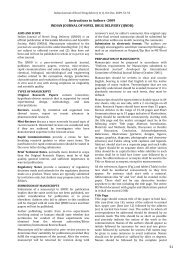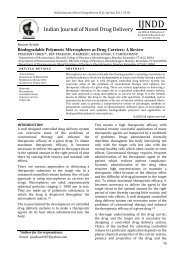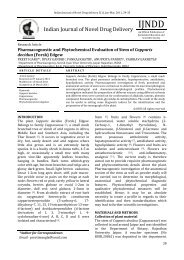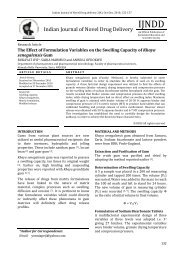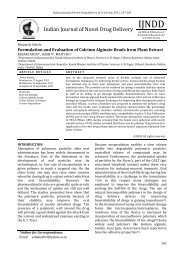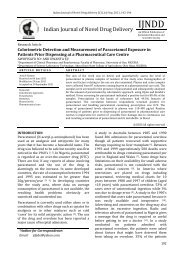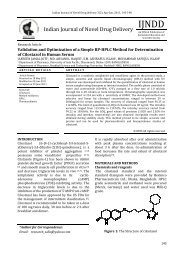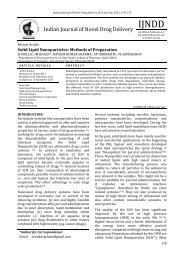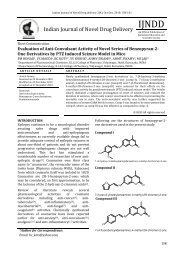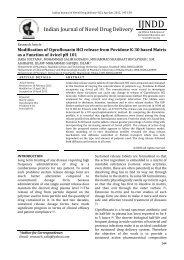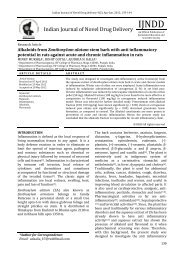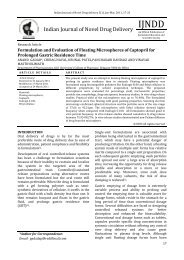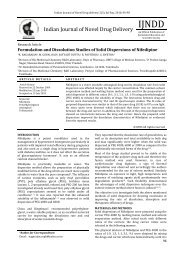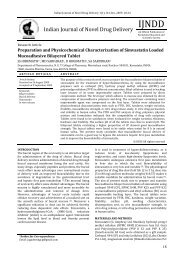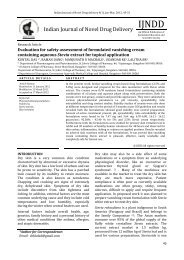Mucoadhesive Polymers - Indian Journal of Novel Drug Delivery
Mucoadhesive Polymers - Indian Journal of Novel Drug Delivery
Mucoadhesive Polymers - Indian Journal of Novel Drug Delivery
You also want an ePaper? Increase the reach of your titles
YUMPU automatically turns print PDFs into web optimized ePapers that Google loves.
Swamy NGN et al / <strong>Indian</strong> <strong>Journal</strong> <strong>of</strong> <strong>Novel</strong> <strong>Drug</strong> <strong>Delivery</strong> 4(1), Jan-Mar, 2012, 2-16<br />
Table 1: Potential advantages and limitations <strong>of</strong> nasal drug delivery<br />
Advantages<br />
• Avoids degradation <strong>of</strong> drug in gastrointestinal tract<br />
resulting from acidic or enzymatic degradation<br />
• Avoids degradation <strong>of</strong> drug resulting from hepatic<br />
first-pass metabolism<br />
• Results in rapid absorption and onset <strong>of</strong> action<br />
• Results in higher bioavailability thus needing lower<br />
doses <strong>of</strong> drug<br />
• Easily accessible, non-invasive route<br />
• Self-medication is possible through this route<br />
• Direct transport into systemic circulation and CNS is<br />
possible<br />
• Offers lower risk <strong>of</strong> overdose<br />
• Does not have any complex formulation requirement<br />
The main reason for this is that they are lowly<br />
permeable and susceptible to the proteases in<br />
the nasal mucosal membrane, so these drugs can<br />
be rapidly cleared from the cavity, by ciliary<br />
movement or enzymatic degradation before they<br />
reach the bloodstream, and cannot cross the<br />
mucosal barriers [13] . Penetration enhancers such<br />
as surfactants [14], bile salts [15,16], fusidate<br />
derivatives [17] , and phospholipids [18] have been<br />
used to improve the drug absorption through<br />
nasal mucosa, but toxicity tests have proved that<br />
they were <strong>of</strong> limited clinical use because <strong>of</strong> their<br />
irreversible damage to nasal mucosa<br />
accompanied with their absorption-enhancing<br />
effects [19] .<br />
Some mucoadhesive polymers, such as cellulose,<br />
polyacrylate, starch, and chitosan, have proven to<br />
be effective on improving intranasal absorption<br />
<strong>of</strong> hydrophilic macromolecules. These polymers<br />
achieve this by increasing the drug residence<br />
time in the nasal cavity or enhancing intranasal<br />
absorption; some <strong>of</strong> them can serve both the<br />
functions. Most <strong>of</strong> these polymers are generally<br />
recognized as safe (GRAS) pharmaceutical<br />
excipients and not absorbed, so they would not<br />
be expected to display systemic toxicity.<br />
Even though a number <strong>of</strong> challenges are still to<br />
be overcome, the encouraging results stimulate<br />
pharmaceutical researchers to exercise further<br />
efforts in order to develop new nasal<br />
formulations to replace the conventional<br />
parenteral products. In this article, the use <strong>of</strong><br />
mucoadhesive polymers for the intranasal<br />
delivery <strong>of</strong> drugs is reviewed. Their ability <strong>of</strong><br />
enhancing the intranasal absorption <strong>of</strong><br />
Limitations<br />
• Volume that can be delivered into nasal cavity is<br />
restricted to 25–200 µl<br />
• High molecular weight compounds cannot be delivered<br />
through this route (mass cut <strong>of</strong>f ~1 kDa)<br />
• Adversely affected by pathological conditions<br />
• Large interspecies variability is observed in this route<br />
• Normal defence mechanisms like mucociliary<br />
clearance and ciliary beating affects the permeability <strong>of</strong><br />
drug<br />
• Enzymatic barrier to permeability <strong>of</strong> drugs<br />
• Irritation <strong>of</strong> nasal mucosa by drugs<br />
• Limited understanding <strong>of</strong> mechanisms and less<br />
developed models at this stage<br />
macromolecular hydrophilic drugs will be<br />
focused on.<br />
<strong>Mucoadhesive</strong> polymers<br />
<strong>Mucoadhesive</strong> polymers [20] are water-soluble<br />
and water insoluble polymers, which are<br />
swellable networks, jointed by cross-linking<br />
agents. These polymers possess optimal polarity<br />
to make sure that they permit sufficient wetting<br />
by the mucus and optimal fluidity that permits<br />
the mutual adsorption and interpenetration <strong>of</strong><br />
polymer and mucus to take place. <strong>Mucoadhesive</strong><br />
polymers that adhere to the mucin-epithelial<br />
surface can be conveniently divided into three<br />
broad classes:<br />
1. <strong>Polymers</strong> that become sticky when placed<br />
in water and owe their mucoadhesion to<br />
stickiness.<br />
2. <strong>Polymers</strong> that adhere through nonspecific,<br />
non-covalent interactions that are<br />
primarily electrostatic in nature (although<br />
hydrogen and hydrophobic bonding may<br />
be significant).<br />
3. <strong>Polymers</strong> that bind to specific receptor site<br />
on tile self-surface.<br />
All three polymer types can be used for drug<br />
delivery<br />
Characteristics <strong>of</strong> an ideal mucoadhesive<br />
polymer [21]<br />
1. The polymer and its degradation products<br />
should be nontoxic and should be<br />
nonabsorbable from the gastrointestinal<br />
tract.<br />
2. It should be non-irritant to the mucous<br />
membrane.<br />
3



